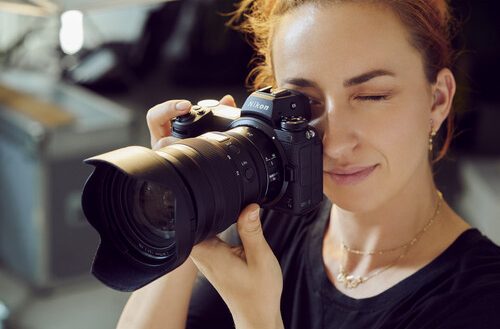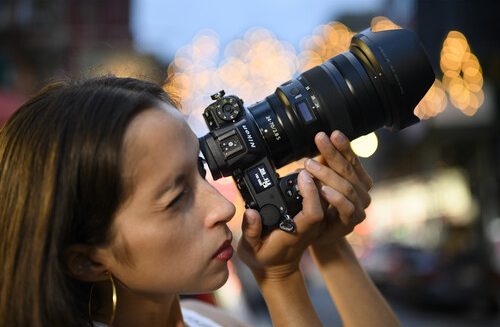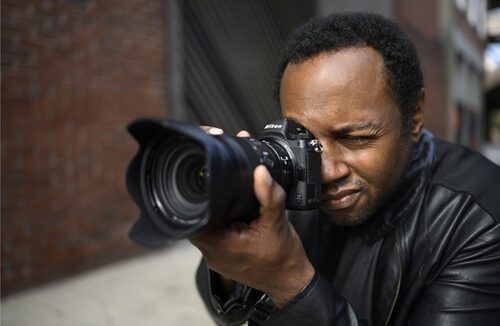Technology moves quickly in the camera world. Every year brings new models with faster processors, higher resolutions, and more advanced autofocus systems. Yet, some cameras continue to hold their own long after launch — and the Nikon Z7 II is one of them.
Originally released as Nikon’s high-resolution full-frame mirrorless camera, the Z7 II built on the strengths of the first-generation Z7 with dual processors, enhanced autofocus, and improved handling…
In 2025, it’s fair to ask whether this high-megapixel workhorse still has what it takes to compete with newer releases like the Z8 or Zf. The answer isn’t just about specs — it’s about performance, reliability, and value. Below, we’ll revisit what makes the Z7 II a capable tool even years after launch, and why it remains a smart buy for photographers today, especially on the used market through trusted platforms like MPB.
Table of Contents
- High-Resolution Powerhouse: Image Quality That Still Impresses
- Performance and Autofocus: A Subtle but Solid Step Up
- Video Capabilities: A Capable but Not Cutting-Edge Hybrid
- Build, Handling, and Ergonomics: Classic Nikon Feel
- Firmware Updates and System Maturity
- Battery Life, Connectivity, and Workflow
- Who the Nikon Z7 II Is Best For in 2025
- Price, Value, and the Used Market
- Verdict: Still Worth Buying in 2025?
- FAQ
High-Resolution Powerhouse: Image Quality That Still Impresses

The Nikon Z7 II’s 45.7MP full-frame BSI CMOS sensor remains one of Nikon’s finest. Even in 2025, few cameras in its class can rival the level of detail and tonal depth this sensor produces. It’s especially impressive for landscape and studio photographers who value crisp textures and rich, natural color rendition. The backside-illuminated design helps maintain cleaner results at higher ISOs, while the native ISO 64 setting allows for exceptional dynamic range in well-lit scenes.
What stands out about the Z7 II’s image performance is its ability to capture both nuance and precision. The lack of an optical low-pass filter ensures razor-sharp detail, making it an outstanding choice for large-format printing or heavy cropping. Combined with dual EXPEED 6 processors, files are rendered quickly and cleanly, whether you’re shooting RAW or JPEG.
In side-by-side comparisons with newer models like the Nikon Z8, the Z7 II still holds its own. While the Z8 may offer better speed and video options, the Z7 II remains the more affordable entry into Nikon’s high-resolution ecosystem, delivering nearly identical image quality in most conditions. For anyone who prioritizes still photography, it’s hard to argue that this sensor has lost its relevance.
Performance and Autofocus: A Subtle but Solid Step Up

The Z7 II refined the performance of its predecessor in meaningful ways. Dual EXPEED 6 processors brought faster overall operation, allowing for 10 frames per second shooting and a deeper buffer. While it’s not designed to rival sports-oriented cameras, that burst speed makes it versatile enough for action sequences, wildlife, or event photography.
The 493-point phase-detect autofocus system covers roughly 90 percent of the frame, offering reliable subject tracking and quick focusing across a wide area. Nikon’s addition of Eye and Face Detection for both humans and animals elevated autofocus consistency, especially for portrait shooters. Firmware updates have since improved the responsiveness and accuracy of these tracking modes, making the Z7 II even better than it was at launch.
In real-world use, the autofocus feels deliberate and dependable. It may not match the blistering subject detection of the Z8, but it rarely disappoints. For many photographers, the combination of accuracy, high resolution, and reliable focus makes the Z7 II a steady performer that’s easy to trust in the field.
Video Capabilities: A Capable but Not Cutting-Edge Hybrid
As discussed by Leigh & Raymond Photography in the video above, when it comes to video, the Z7 II strikes a balance between flexibility and simplicity. It records UHD 4K at up to 60p, along with Full HD at 120p for smooth slow motion playback. Footage looks excellent straight out of camera, with natural color and impressive sharpness. The inclusion of N-Log and HLG options means you can push the dynamic range further in post-production, and the 10-bit HDMI output adds professional-level grading flexibility.
Firmware updates expanded the camera’s capabilities to include raw output to Blackmagic Design recorders, and the optional ProRes RAW upgrade opens up even more color control for advanced editors. These features make the Z7 II a solid hybrid camera for those who primarily shoot stills but need reliable video when the situation calls for it.
That said, limitations exist — notably the 30-minute recording cap and lack of internal 10-bit recording. For creators who shoot long-form video or prefer advanced codecs without external recorders, the Z8 or Z6 III are better choices. But for photographers who occasionally create cinematic clips, the Z7 II’s video features remain more than capable in 2025.
Build, Handling, and Ergonomics: Classic Nikon Feel

Pick up the Z7 II and you’ll immediately recognize Nikon’s design DNA. The magnesium alloy body feels solid and confidence-inspiring, and the weather-sealing ensures it can handle dust, moisture, and cold with ease. The ergonomics are among the best in the mirrorless class, with a deep grip and intuitive button layout that feels comfortable during long shoots.
The 3.2-inch tilting touchscreen is bright, detailed, and responsive, while the 3.6-million-dot electronic viewfinder delivers crisp, lag-free viewing. Both displays make composing and reviewing images a seamless experience. The addition of a top-panel status display gives you instant access to essential settings, a small touch that professionals appreciate.
The inclusion of dual memory card slots—one CFexpress Type B/XQD and one UHS-II SD—was a major upgrade over the original Z7’s single slot. It provides flexibility for overflow, backup, or segregated file storage. Combined with USB-C charging and support for Nikon’s MB-N11 battery grip, the Z7 II offers a user experience that feels both modern and practical.
Firmware Updates and System Maturity

One of the biggest reasons the Z7 II remains relevant in 2025 is Nikon’s continued firmware support. Over the years, updates have improved autofocus precision, refined Eye Detection, and added creative options like Portrait Impression Balance for better skin tone control. Even menu functionality and live view usability have seen thoughtful refinements.
The ability to update firmware directly through Nikon’s SnapBridge app adds convenience, removing the need for SD card transfers. This type of ongoing software support helps keep the Z7 II feeling fresh, even as newer models arrive.
Just as important, the Z-mount system itself has matured dramatically since the Z7 II launched. With dozens of excellent native lenses now available—from compact primes to professional zooms—the camera benefits from a far richer ecosystem than it had in 2020. That lens diversity ensures the Z7 II can serve nearly any photographic niche with professional results.
Battery Life, Connectivity, and Workflow

The Z7 II’s EN-EL15c battery provides solid endurance, rated for roughly 400-420 shots per charge, though real-world use often exceeds that when power-saving modes are enabled. The ability to power and charge the camera via USB-C makes it adaptable for travel, studio, and time-lapse work where extended operation is essential.
Wireless connectivity via Wi-Fi and Bluetooth through the SnapBridge app simplifies file transfers and remote shooting. It’s not the fastest connection by modern standards, but it’s dependable. Firmware updates through the app also make maintenance much easier than before. The app’s ability to control live view and trigger the shutter remotely is particularly helpful for tripod-based or self-portrait work.
Dual card slots not only offer redundancy but also give professionals peace of mind when shooting critical assignments. Combined with Nikon’s thoughtful power and connectivity design, the Z7 II remains efficient in a modern workflow.
Who the Nikon Z7 II Is Best For in 2025

The Z7 II continues to cater to photographers who demand precision and detail above all else. It’s ideal for landscape photographers who want maximum dynamic range, portrait shooters who appreciate lifelike tones, and commercial photographers producing high-resolution imagery. Its color depth and clarity make it a trusted companion for print work, product photography, and fine art.
Hybrid creators will appreciate its video features, even if they’re not class-leading, while its durability and weather sealing make it a strong option for travel and outdoor work. It’s not built for sports photographers who need blazing frame rates, but for most professional and enthusiast users, it delivers a perfect blend of quality, control, and reliability.
In short, the Z7 II in 2025 remains an excellent fit for anyone who values consistency and image excellence more than novelty. It’s a camera that rewards skill and patience with results that still rival the best of today.
Price, Value, and the Used Market

One of the biggest arguments in favor of the Z7 II today is value. While its launch price positioned it firmly in the professional bracket, the cost has dropped considerably since then, especially on the used market. Trusted platforms like MPB offer the Z7 II in excellent condition at a fraction of the original price. MPB’s transparent grading system, fair trade-in options, and generous warranty make it a go-to resource for buying and selling used gear with confidence.
Buying a used Z7 II through MPB not only saves money but also ensures access to Nikon’s robust mirrorless ecosystem at an affordable entry point. Considering the camera’s solid build and proven reliability, it’s a purchase that can easily deliver years of professional use without compromise.
For photographers looking to upgrade from a DSLR or step into full-frame mirrorless without breaking the bank, the Z7 II offers exceptional long-term value. It’s a camera that still delivers top-tier image quality, thoughtful ergonomics, and dependable performance at a very approachable price.
Verdict: Still Worth Buying in 2025?

Five years after its release, the Z7 II remains a remarkably capable camera. While newer models may edge it out in speed, autofocus intelligence, or video specs, the fundamentals—sensor quality, color accuracy, and build—are still first-rate. It’s a camera that rewards deliberate photography, offering an experience that feels timeless rather than outdated.
If your focus is on capturing the best possible still images with Nikon’s mirrorless system, the Z7 II is absolutely worth buying in 2025. Whether new or used, it remains a professional-grade tool with the kind of refinement that never goes out of style. You can find great deals and certified used options through MPB, making now the perfect time to invest in one.
FAQ
Is the Nikon Z7 II still a good camera for professional work?
Yes. The Z7 II’s 45.7MP sensor, strong dynamic range, and excellent color depth make it fully capable of handling professional photography in 2025. It’s widely used for portraits, landscapes, and commercial work.
How does the Nikon Z7 II compare to the Z8?
The Z8 offers faster burst shooting, more advanced autofocus, and better video features, but it also costs more. The Z7 II delivers similar image quality at a lower price, especially on the used market.
Can the Nikon Z7 II shoot 4K 60p video?
Yes, the Z7 II supports 4K 60p recording with N-Log and HLG support, and it can output 10-bit video via HDMI. It’s excellent for hybrid shooters who prioritize stills but want strong video capabilities.
Is the Nikon Z7 II good for wildlife or sports?
While it’s not built for ultra-fast action, the Z7 II’s 10 fps burst rate and accurate autofocus make it suitable for moderate wildlife or sports photography with proper technique.
Where is the best place to buy a used Nikon Z7 II?
The best place to find a quality used Z7 II is on MPB, which offers transparent grading, fair prices, and a warranty for peace of mind.
Friendly disclaimer: Our articles may contain affiliate links that support us without costing you more, and sometimes we spice things up with sponsored content—but only for products we truly stand behind!

